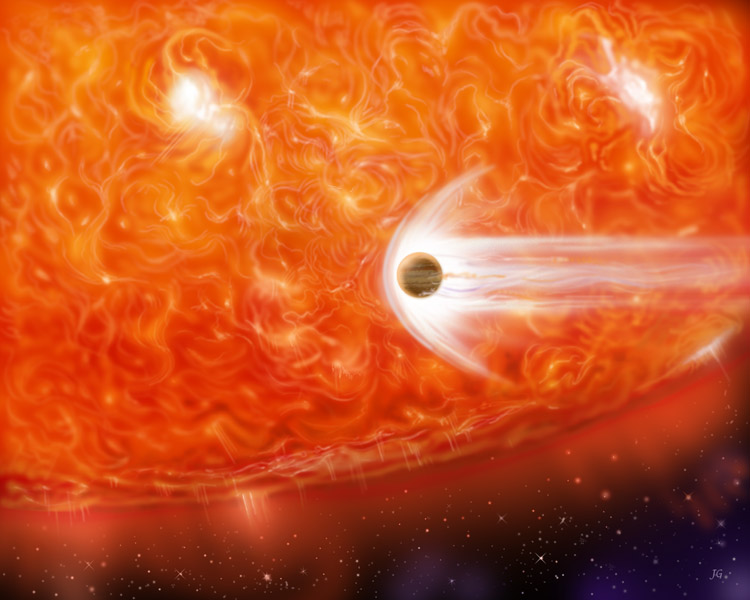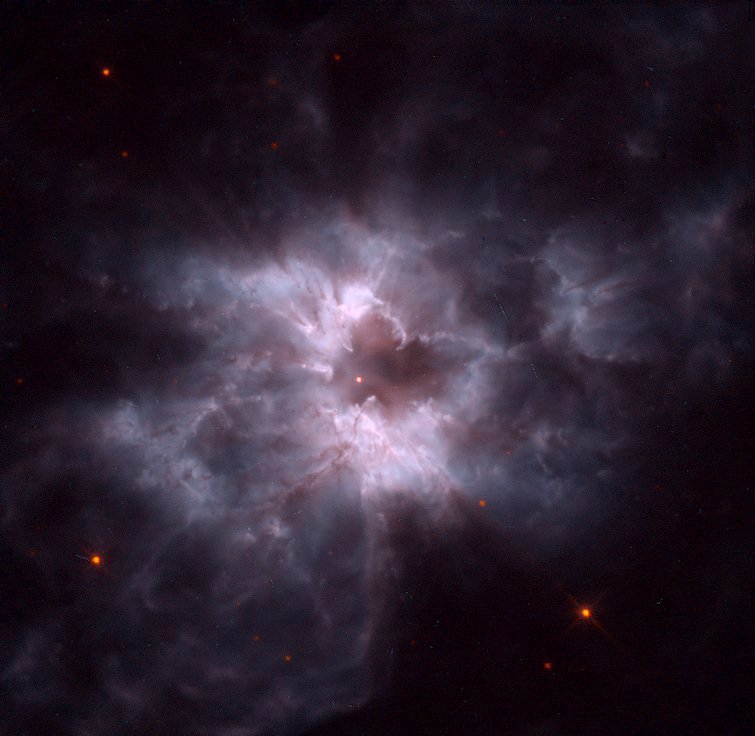
 Copyright © Michael Richmond.
This work is licensed under a Creative Commons License.
Copyright © Michael Richmond.
This work is licensed under a Creative Commons License.
The Big Bang model describes the current universe as expanding. Based on the latest observations, we conclude that the expansion will continue forever. What will happen to Earth, the Solar System, and the rest of the universe as time goes by? Fred Adams and Gregory Laughlin have written a very good article on the future of the universe. You can find it in the August, 1998, issue of Sky and Telescope, too. They divide time into a series of "Ages".
Let's look first at the evolution of the Solar System (over the next ten or so billion years), and then the evolution of the entire universe.
Our Solar System has been around for about 4.5 billion years. The Sun is a star of relatively low mass, which means that it burns its nuclear fuel relatively slowly. In the core of the Sun, hydrogen atoms are fusing to form helium. The energy released by this reaction pushes the solar material outwards, supporting it against gravity. Eventually, the radiation makes its way to the surface, then flies into space as (mostly) visible light.
In about 6 billion years, the Sun will have converted almost all the hydrogen in its core into helium. Eventually, the helium in the core will start to fuse together to form carbon. This reaction takes place at much higher pressures and temperatures than hydrogen fusion, and releases much more energy. The extra energy generated in the core will push the outer layers of the Sun far, far beyond their current position. As they are pushed outwards, the outermost layers of the Sun's atmosphere will cool down from the current 5700 degrees Kelvin to perhaps 4000 or 3500 degrees Kelvin. The Sun will swell up and become cooler and redder: a red giant.
The radius of the Sun will grow very large during this phase of its evolution. Its outer layers will certainly engulf the planet Mercury, possibly Venus, and maybe even the Earth!

But, even if the Earth escapes direct contact with the solar atmosphere, it will be doomed nonetheless: the solar luminosity will increase by several thousand as it becomes a red giant, heating the Earth to a temperature of about 2000 Kelvin (about 3000 Fahrenheit). The atmosphere will fly off into space, the oceans will boil away, much of the continents will melt.

painting by William K. Hartmann
The red giant phase of life is a brief one: after only about 1 billion years, the Sun will deplete all the helium in its core. It does not have sufficient mass to drive pressures and temperatures high enough to fuse carbon into heavier elements. Instead, with no source of energy at its center, the Sun's luminosity will fall drastically. Its swollen outer layers will be ejected into space, forming a planetary nebula, and leaving a small, dense remnant behind: a white dwarf.

Although initially very hot (40,000 Kelvin or so), the white dwarf will cool as it radiates away its internally energy. After several billion years, its temperature will have decreased to a few thousand degrees Kelvin, and its light will have dimmed to a dull red. The Earth's surface will cool and again solidify, then continue to cool far past our current temperature. Ten billion years from now, what remains of the Earth will be frozen, more than a hundred degrees below zero. Any oxygen or nitrogen gas on the surface (emitted by volcanic activity, perhaps) will be frozen as a frost on the ground.
Stelliferous means "star-bearing". The current universe is indeed stelliferous: we see new stars being created in galaxies almost everywhere we look. Stars are, in fact, one of the dominant features of the universe right now. Just go outside and look!
When we look at our Milky Way galaxy (or other galaxies) from an overall point of view, we find that much of its light -- perhaps more than half -- comes from a relatively few stars: massive, blue, young stars, less than one billion years old, emit huge amounts of ultraviolet, visible, and infrared radiation. They are often grouped together into star-forming regions, sometimes lighting up gas in their vicinity to form HII regions.

But these massive stars run through their store of nuclear fuel very quickly. The rate at which fusion occurs in a stellar core depends very sensitively on the temperature and pressure. Low-mass stars, with lower temperatures and pressures, consume their nuclear fuel much more slowly than high-mass stars. Even though the low-mass stars start with much less fuel, they continue to burn it for a much longer time.

Initial mass of star lifetime
----------------------------------------------------------
10 solar masses 0.02 billion years
5 0.07
2 1
1 10
0.5
0.2 1000
0.08 10000
Objects will masses less than about 0.08 solar do not create high enough temperatures or densities in their cores to permit fusion -- so they do not become stars.
The stars of lowest mass are small, cool, and dim: we call them red dwarfs. Their luminosities are so low -- less than one percent of the Sun's -- that only planets with very small orbits could be warm enough to have liquid water. The most frugal of them may continue to burn hydrogen into helium for another 10,000 billion, or 10 trillion, years.
But eventually, even the red dwarfs will run out of fuel. They will cool off and become black dwarfs: chunks of helium and heavier elements bound together by gravity, radiating only tiny amounts of energy as they very slowly settle to a final shrunken state.
After about 10^(14), or 100 trillion, years, the stars are dead.
After the Stelliferous age, the universe is very different, for two reasons. First, stars are no longer shining. Second, galaxies which are not gravitationally bound to each other have been carried far away by the expansion of the universe. After several passes between our Milky Way and Andromeda, the two galaxies will merge. After trillions of years, all the galaxies in our Local Group will have coalesced into one big object. But all the other galaxies in the universe will have continued to move farther and farther away: by 10^(14) years in the future, even our nearest unbound neighbors will be more than one million Megaparsecs away from us.
The dominant forms of matter are now mostly dead stars, in several forms:
The atoms in all these objects are unlike those in ordinary matter, due to their high density. Physicists call this sort of material degenerate, and that term gives its name to this Age.
Since these objects are not burning any fuel, they do not radiate light. The Degenerate Age is dark.
Over the course of this Age, gravity causes two competing effects.
If a remnant happens to pass close to a black hole, it may be torn apart. The resulting material may form an accretion disk around the black hole, spiralling inwards and emitting radiation as it goes.

The accretion process might last a few years, but will inevitably die away when all the material has fallen into the black hole.
If two white dwarfs with a combined mass of more than about 1.4 solar masses happen to merge, the resulting object undergoes runaway thermonuclear fusion. The result is a Type Ia supernova. Very, very rarely, the darkness of the Degenerate Age is dispelled for a few weeks while a supernova explodes.
At a time of 10^(25) years, the material in the "Local Galaxy" consists of isolated stellar remnants and black holes. Everything is cold and dark.
Some theories of physics predict that protons -- one of the fundamental particles which make up matter -- ought to be unstable over very long timescales. If those theories are correct, then after 10^(30) years or so, the protons in brown dwarfs, white dwarfs, and neutron stars will start to decay. The decaying protons turn into radiation, which flies off into the dark. Eventually, all these remnants disintegrate, leaving behind nothing but electrons, positrons, neutrinos, and radiation.
Only the black holes would be left.
If protons really do decay, then after about 10^(30) years, black holes will be the only collections of matter which remain. Do they last forever, slowly orbiting each other in the isolated, coalesced galaxies?
No!
Black holes, it turns out, do emit a very, very small amount of radiation. Classically, nothing can escape their gravitational pull, not even light; but the rules of quantum mechanics permit a process by which photons or other elementary particles may -- on very rare occasions -- be emitted from the black hole. This is sometimes called "Hawking radiation." Under ordinary circumstances, it is minimal: the radiation emitted by a black hole of one solar mass corresponds to a temperature of 0.0000001 degrees Kelvin.
Nonetheless, during the Black Hole Age, there is plenty of time for this miniscule amount of radiation to carry away a significant portion of a black hole's mass. Moreover, as a black hole loses mass, its temperature and luminosity rise ... so the process speeds up. Eventually, even the most massive black holes must evaporate due to this radiation.
Mass of black hole Time to evaporate
-------------------------------------------------------
7 x 10^(22) kg (Moon) 10^(43) years
6 x 10^(24) kg (Earth) 10^(49) years
2 x 10^(30) kg (Sun) 10^(66) years
2 x 10^(36) kg (million Sun) 10^(84) years
2 x 10^(42) kg (galaxy) 10^(102) years
As its mass decreases, the amount of radiation emitted by a black hole increases. During the last few seconds of its life, an evaporating black hole emits a burst of light, X-rays, and gamma rays. The cold, dark space of the Black Hole Age will very, very, very occasionally be lit up as a black hole ends its life.
After about 10^(100) years, all the black holes are gone.
After all the black holes have evaporated, (and after all the ordinary matter made of protons has disintegrated, if protons are unstable), the universe will be nearly empty. Photons, neutrinos, electrons and positrons will fly from place to place, hardly ever encountering each other. It will be cold, and dark, and there is no known process which will ever change things.
Not a happy ending.
For more information,
 Copyright © Michael Richmond.
This work is licensed under a Creative Commons License.
Copyright © Michael Richmond.
This work is licensed under a Creative Commons License.